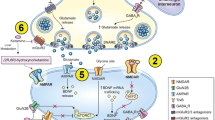Abstract
Fluoxetine (FL) is being used in neuropharmacology as a tool for studying various functional roles of serotoninergic neurons. Its kinetics was studied in rats, a species widely used in neurochemical studies, after IV (2.5–10 mg/kg) and oral (5–20 mg/kg) administration. When injected IV the drug followed apparent first-order kinetics up the 10 mg/kg dose. Its volume of distribution was large and total body clearance was relatively high compared to liver blood flow. The mean elimination half-lives (t 1/2) of FL and its active metabolite norfluoxetine (NFL) were about 5 and 15 h, respectively. The mean blood:plasma concentration ratios of FL and NFL approached unity and plasma protein binding was 85–90% for both compounds. After oral doses the kinetics of FL were complex. At the lowest dose tested (5 mg/kg) the drug was efficiently extracted by the liver (extraction ratio about 60%), resulting in bioavailability of only about 38%. Plasma areas under the curve (AUC) of the metabolite were approximately the same as after IV injection of the same dose; consequently the metabolite-to-parent drug ratio after oral administration (about 5) was approximately twice that after IV injection of FL (about 2.5). At higher doses, however, the oral bioavailability (e.g.C max and AUC) appeared greater than expected, possibly because of transient saturation of FL first-pass metabolism in the case of the 10 mg/kg dose and concomitant saturation of elimination kinetics at the higher dose (20 mg/kg). The apparent eliminationt 1/2 of FL markedly increased and the metabolite-to-parent drug ratio declined with the higher dose, this also being consistent with saturable elimination. Brain concentrations reflected the plasma kinetics of FL and NFL and the metabolite-to-parent drug ratio varied with dose and time of administration and was modified at the highest dose tested. FL and its metabolite NFL distributed almost evenly in discrete brain areas and subcellular distribution was similar for both compounds. Neurochemical studies of FL should consider the formation of the active metabolite NFL and extrapolation of data across animal species requires consideration of dose dependence in the rat.
Similar content being viewed by others
References
Aronoff GR, Bergstrom RF, Pottratz ST, Sloan RS, Wolen RL, Lemberger L (1984) Fluoxetine kinetics and protein binding in normal and impaired renal function. Clin Pharmacol Ther 36:138–144
Benet LZ, Galeazzi RL (1979) Noncompartmental determination of the steady-state volume of distribution. J Pharm Sci 68:1071–1074
Benfield P, Hell RC, Lewis SP (1986) Fluoxetine. A review of its pharmacodynamic and pharmacokinetic properties, and therapeutic efficacy in depressive illness. Drugs 32:481–508
Blackwell B, Simon JS (1986) Second-generation antidepressants. Drugs of Today (Medicamentos de Actualidad) 22:611–633
Boxenbaum H (1980) Interspecies variation in liver weight, hepatic blood flow, and antipyrine intrinsic clearance: extrapolation of data to benzodiazepines and phenytoin. J Pharmacokinet Biopharm 8:165–176
Eichelbaum M (1988) Pharmacokinetic and pharmacodynamic consequences of stereoselective drug metabolism in man. Biochem Pharmacol 17:93–96
Farid NA, Bergstrom RF, Lemberger L, Ziege EA, Tenbarge J, Wolen RL, Dhahir PH (1986) Studies on the disposition of fluoxetine at steady state in man with the aud of stable and radioactive isotopes. In: 15th. CINP Congress, San Juan, Puerto Rico, Dec. 14–17, Book of Abstracts, P-234
Fuller RW, Snoddy HD (1986) Fluoxetine enantiomers as antagonists ofp-chloroamphetamine effects in rats. Pharmacol Biochem Behav 24:281–284
Fuller RW, Rathbun RC, Parli CJ (1976) Inhibition of drug metabolism by fluoxetine. Res Commun Chem Pathol Pharmacol 13:353–356
Fuller RW, Snoddy HD, Perry KW, Bymaster FP, Wong DT (1978) Importance of duration of drug action in the antagonism ofp-chloroamphetamine depletion of brain serotonin. Comparison of fluoxetine and chlorimpramine. Biochem Pharmacol 27:193–198
Glowinski J, Iversen LL (1966) Regional studies of catecholamines in the rat brain. I. The disposition of [3H]norepinephrine, [3H]dopamine and [3H]DOPA in various regions of the brain. J Neurochem 13:655–669
Horng JS, Wong DT (1976) Effects of serotonin uptake inhibitor, Lilly 110140, on transport of serotonin in rats and human blood platelets. Biochem Pharmacol 25:865–867
Lowry OH, Rosebrough NJ, Farr AL, Randall RJ (1951) Protein measurement with the Folin phenol reagent. J Biol Chem 193:265–275
Parli CJ, Hicks J (1974) In vivo demethylation of Lilly 110140: 3-(p-trifluoromethylphenoxy)-N-methyl-3-phenylpropylamine to an active metabolite — Lilly 103947. Fed Proc 33:560
Robertson DW, Krushinski JH, Fuller RW, Leander JD (1988) Absolute configurations and pharmacological activities of the optical isomers of fluoxetine, a selective serotonin-uptake inhibitor. J Med Chem 31:1412–1417
Robinson CP (1988) Fluoxetine (Prozac®): An antidepressant which selectively inhibits serotonin reuptake. Drugs of Today (Medicamentos de Actualidad) 24:7–13
Schmidt MJ, Fuller RW, Wong DT (1988) Fluoxetine, a highly selective serotonin reuptake inhibitor: a review of preclinical studies. Br J Psychiatry [Suppl 3] 153:40–46
Whittaker VP, Barker LA (1972) The subcellular fractionation of brain tissue with special reference to the preparation of synaptosomes and their component organelles. In: Fried R (ed) Methods of neurochemistry, vol 2. Dekker, New York, pp 1–50
Williams K, Lee E (1985) Importance of drug enantiomers in clinical pharmacology. Drugs 30:333–354
Wong DT, Bymaster FP, Reid LR, Fuller RW, Perry KW (1985) Inhibition of serotonin uptake by optical isomers of fluoxetine. Drug Dev Res 6:397–403
Author information
Authors and Affiliations
Rights and permissions
About this article
Cite this article
Caccia, S., Cappi, M., Fracasso, C. et al. Influence of dose and route of administration on the kinetics of fluoxetine and its metabolite norfluoxetine in the rat. Psychopharmacology 100, 509–514 (1990). https://doi.org/10.1007/BF02244004
Received:
Revised:
Issue Date:
DOI: https://doi.org/10.1007/BF02244004




